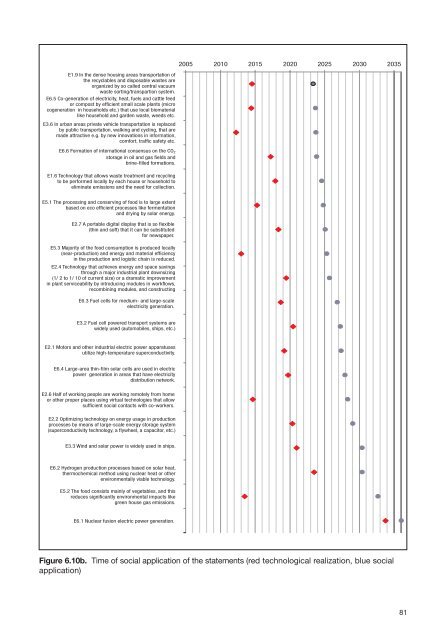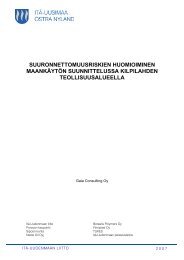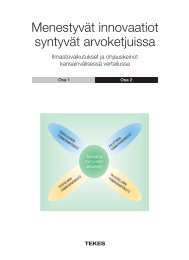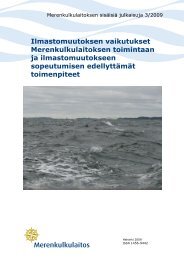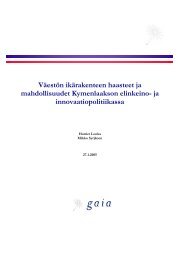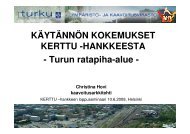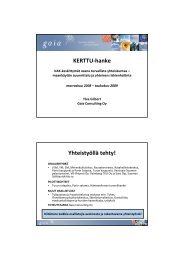227/08 Social challanges s the basis for foresight - Gaia
227/08 Social challanges s the basis for foresight - Gaia
227/08 Social challanges s the basis for foresight - Gaia
You also want an ePaper? Increase the reach of your titles
YUMPU automatically turns print PDFs into web optimized ePapers that Google loves.
E1.9 In <strong>the</strong> dense housing areas transportation of<br />
<strong>the</strong> recyclables and disposable wastes are<br />
organized by so called central vacuum<br />
waste sorting/transpartion system.<br />
E6.5 Co-generation of electricity, heat, fuels and cattle feed<br />
or compost by efficient small scale plants (micro<br />
cogeneration in households etc.) that use local biomaterial<br />
like household and garden waste, weeds etc.<br />
E3.6 In urban areas private vehicle transportation is replaced<br />
by public transportation, walking and cycling, that are<br />
made attractive e.g. by new innovations in in<strong>for</strong>mation,<br />
com<strong>for</strong>t, traffic safety etc.<br />
E6.6 Formation of international consensus on <strong>the</strong> CO2<br />
storage in oil and gas fields and<br />
brine-filled <strong>for</strong>mations.<br />
E1.6 Technology that allows waste treatment and recycling<br />
to be per<strong>for</strong>med locally by each house or household to<br />
eliminate emissions and <strong>the</strong> need <strong>for</strong> collection.<br />
E5.1 The processing and conserving of food is to large extent<br />
based on eco efficient processes like fermentation<br />
and drying by solar energy.<br />
E2.7 A portable digital display that is so flexible<br />
(thin and soft) that it can be substituted<br />
<strong>for</strong> newspaper.<br />
E5.3 Majority of <strong>the</strong> food consumption is produced locally<br />
(near-production) and energy and material efficiency<br />
in <strong>the</strong> production and logistic chain is reduced.<br />
E2.4 Technology that achieves energy and space savings<br />
through a major industrial plant downsizing<br />
(1/ 2 to 1/ 10 of current size) or a dramatic improvement<br />
in plant serviceability by introducing modules in workflows,<br />
recombining modules, and constructing<br />
E6.3 Fuel cells <strong>for</strong> medium- and large-scale<br />
electricity generation.<br />
E3.2 Fuel cell powered transport systems are<br />
widely used (automobiles, ships, etc.)<br />
E2.1 Motors and o<strong>the</strong>r industrial electric power apparatuses<br />
utilize high-temperature superconductivity.<br />
E6.4 Large-area thin-film solar cells are used in electric<br />
power generation in areas that have electricity<br />
distribution network.<br />
E2.6 Half of working people are working remotely from home<br />
or o<strong>the</strong>r proper places using virtual technologies that allow<br />
sufficient social contacts with co-workers.<br />
E2.2 Optimizing technology on energy usage in production<br />
processes by means of large-scale energy storage system<br />
(superconductivity technology, a flywheel, a capacitor, etc.)<br />
E3.3 Wind and solar power is widely used in ships.<br />
E6.2 Hydrogen production processes based on solar heat,<br />
<strong>the</strong>rmochemical method using nuclear heat or o<strong>the</strong>r<br />
environmentally viable technology.<br />
E5.2 The food consists mainly of vegetables, and this<br />
reduces significantly environmental impacts like<br />
green house gas emissions.<br />
E6.1 Nuclear fusion electric power generation.<br />
2005 2010 2015 2020 2025 2030 2035<br />
Figure 6.10b. Time of social application of <strong>the</strong> statements (red technological realization, blue social<br />
application)<br />
81


